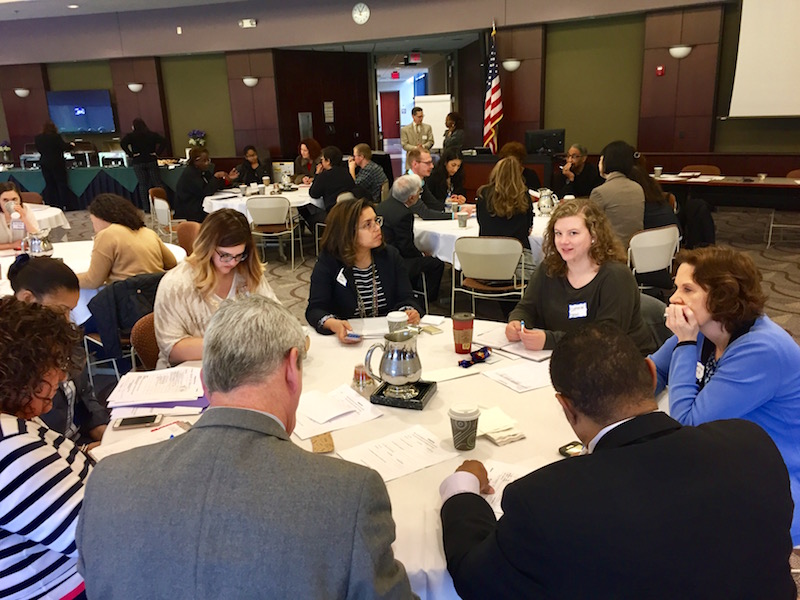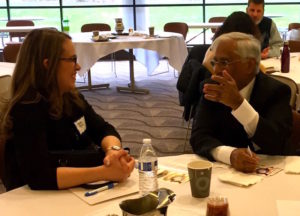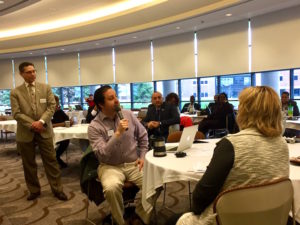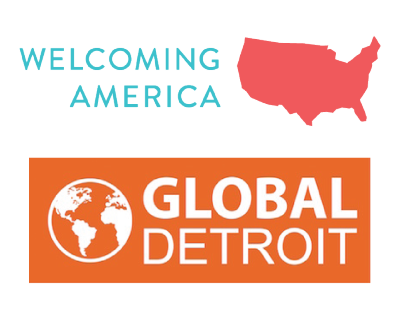Not My Parents’ Macomb County

The Welcoming Economies Global Network (WE Global) and the New American Economy traveled to Michigan to join the One Macomb initiative, a county-initiated forum and resource for all matters relating to the enhancement of diversity and inclusion in Macomb County, to release compelling new research about the incredible diversity and economic contributions that immigrants bring to the region.
The data reflects the dynamics that many suburban Midwest communities are facing as the country struggles with changing demographics. In short, the data demonstrates how diverse Macomb County has become over the past 25 years. In 1980, Macomb County was designated by Republican political strategist Lee Atwater as the home of the “Reagan Democrats,” working-class white voters who traditionally voted with organized labor for Democratic candidates who could be moved by social issues to vote for Ronald Reagan. And as recently as 1990, the U.S. Census reported that Macomb County was 96% white. The county has been identified by national political pundits as a bellwether of the U.S. electorate and immigration is one of a number of issues that may hold keen interest for its largely working-class voters.
 Today, Macomb County government helped to launch the One Macomb initiative to welcome the immigrants and other diverse groups that are part of dynamic demographic change. The data released by One Macomb, obtained as part of the Gateways for Growth program from Welcoming America and the New American Economy, shatters the old view of Macomb County, particularly in regards to the foreign-born. Macomb County is home to almost 90,000 immigrants, making it more internally diverse than Wayne County where Detroit is located (Macomb is 10.4% foreign born, while Wayne is only 8.4%. Oakland is almost at the national average and is 12.4%).
Today, Macomb County government helped to launch the One Macomb initiative to welcome the immigrants and other diverse groups that are part of dynamic demographic change. The data released by One Macomb, obtained as part of the Gateways for Growth program from Welcoming America and the New American Economy, shatters the old view of Macomb County, particularly in regards to the foreign-born. Macomb County is home to almost 90,000 immigrants, making it more internally diverse than Wayne County where Detroit is located (Macomb is 10.4% foreign born, while Wayne is only 8.4%. Oakland is almost at the national average and is 12.4%).
Macomb County’s Sterling Heights has the second largest immigrant population of any Michigan city with 36,610, trailing Detroit by only a couple thousand immigrants. At 27.8% foreign-born, Sterling Heights is more than twice as foreign-born as the nation as a whole. Macomb County has made significant progress as a welcoming community with advances in language access and supporting naturalization efforts, to name a few. As Macomb County’s population continues to grow in large part due to its attraction of immigrants, ethnic and business leaders and residents are embracing policies and programs that welcome new immigrant residents, thereby creating jobs and boosting the local economy.
WE Global’s Christina Pope presented to the nearly 100 attendees of the One Macomb meeting and spoke about the importance of immigration to our nation’s economy. She described the work that Welcoming America has been doing across the nation and, in particular, across the Midwest.
 Other important facts undergird the tremendous economic contributions that Macomb County’s immigrants make. There are nearly 5,000 self-employed immigrants whose businesses generate over $50 million in business income in 2014. These businesses represent 15% of all the businesses in Macomb County. Macomb County’s immigrants are highly educated. 35.1% possess a four-year degree or graduate degree (compared to 23.6% of Macomb’s U.S.-born population, and slightly more than 26% for the state as a whole).
Other important facts undergird the tremendous economic contributions that Macomb County’s immigrants make. There are nearly 5,000 self-employed immigrants whose businesses generate over $50 million in business income in 2014. These businesses represent 15% of all the businesses in Macomb County. Macomb County’s immigrants are highly educated. 35.1% possess a four-year degree or graduate degree (compared to 23.6% of Macomb’s U.S.-born population, and slightly more than 26% for the state as a whole).
Other interesting facts included in the data are that most (62.3%) immigrants in the county have become naturalized citizens. Top countries of origin are diverse and include Iraq (24.5%), India (8.2%), Poland (6.7%), the Philippines (4.9%), and Bangladesh (4.7%), with 51% of the immigrants coming from other countries not in the top five. Lastly, 38.3% of the immigrants who moved to Macomb County in the recent past came from outside the U.S. directly to Macomb County, 41.1% came from other Michigan communities, and 20.6% came from other U.S. states.
In short, immigrants to Macomb County have helped make the county a vibrant place. From contributing the high-tech skills and brain power to the county’s dynamic defense, automotive design, and health industries, to helping to revitalize the commercial and residential neighborhoods in older inner-ring suburbs like Warren and Sterling Heights, immigrants are an important part of the county’s fabric. One Macomb has developed an operating agreement for the Macomb County Diversity and Inclusion Collaborative, signed by more than two dozen partner agencies, and is poised to help Macomb continue to be a place where all individuals and groups live, work, and recreate harmoniously with all others, and participate fully, equally, and equitably in all institutions and aspects of Macomb County life.
In March 2016, Welcoming America and the New American Economy selected 20 communities to receive technical assistance and data about the impact immigrants have on their local economy. Eight (8) of these communities are WE Global members, including Akron, Columbus, Detroit (city, separate award from Macomb County whose award included funding for technical assistance), Indianapolis, Lancaster, Pittsburgh, and Upstate New York.



